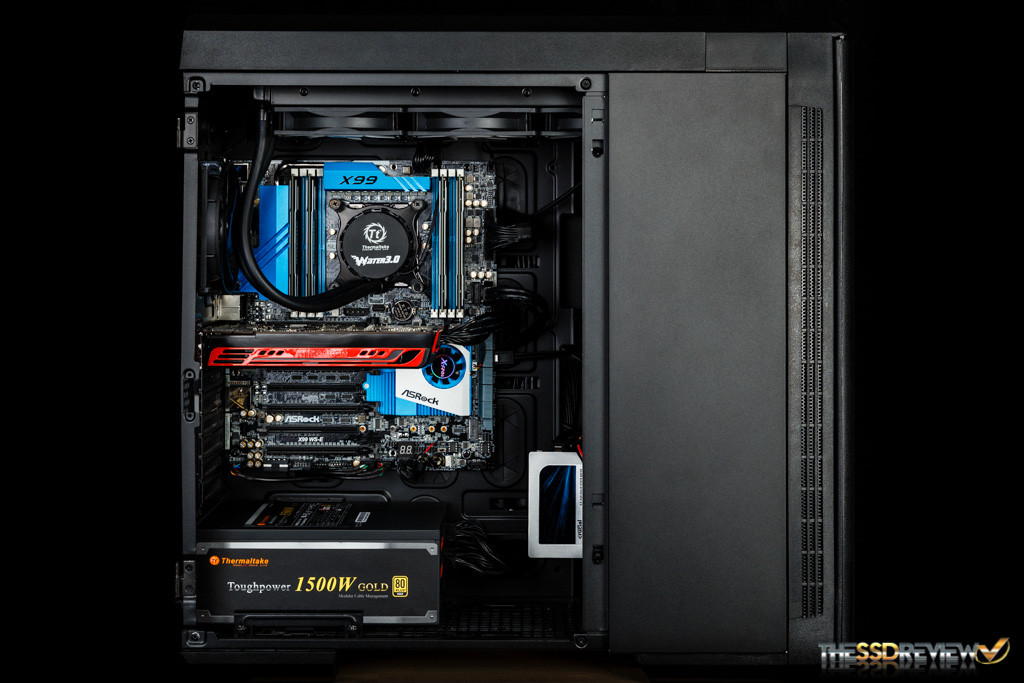TEST SETUP AND METHODOLOGY
In testing all enterprise drives we focus on long term stability. In doing so, we stress products not only to their maximum rates, but also with workloads suited to enterprise environments. We use many off-the-shelf tests to determine performance, but we also have specialized tests to explore specific behaviors we encounter. With enterprise drives, you will see that we do not focus on many consumer level use-cases.
When testing SSDs, the drive is purged and then preconditioned into a steady state before capturing its performance results. We also disable all write caching on the DUT when possible, this ensures consistent results that are complaint with SNIA standards. Our hope is that we present tangible results that provide relevant information to the buying public.
SYSTEM COMPONENTS
| PC CHASSIS: | Thermaltake Urban T81 |
| MOTHERBOARD: | ASRock X99 WS-E |
| CPU: | Intel Xeon E5-2690 v3 |
| CPU COOLER: | Thermaltake Water 3.0 Ultimate |
| POWER SUPPLY: | Thermaltake Toughpower 1500W Gold |
| GRAPHICS: | MSI GT 720 |
| SYSTEM COOLING: | be quiet! Silent Wings 2 |
| MEMORY: | Crucial Ballistix Sport DDR4 2400MHz |
| STORAGE: | Crucial MX200 500GB |
| OS: | Windows Server 2012 R2 |
| MOBO FIRMWARE: | 1.70 |
This Test Bench build was the result of some great relationships and purchase; our appreciation goes to those who jumped in specifically to help the cause. Key contributors to this build are our friends at ASRock for the motherboard and CPU, be quiet! for the cooling fans, and Thermaltake for the case. We have detailed all components in the table below and they are all linked should you wish to make a duplicate of our system as so many seem to do, or check out the price of any single component. As always, we appreciate your support in any purchase through our links!
SNIA TESTING
The Storage Networking Industry Association has an entire industry accepted performance test specification for solid state storage devices. Some of the tests are complicated to perform, but they allow us to look at some important performance metrics in a standard, objective way.

SNIA’s Performance Test Specification (PTS) includes IOPS testing, but it is much more comprehensive than just running 4KB writes with Iometer. SNIA testing is more like a marathon than a sprint. In total, there are 25 rounds of tests, each lasting 56 minutes. Each round consists of 8 different block sizes (512 bytes through 1MB) and 7 different access patterns (100% reads to 100% writes). After 25 rounds are finished (just a bit longer than 23 hours), we record the average performance of 4 rounds after we enter steady state.
- Purge: Secure Erase, Format Unit, or vender specific
- Preconditioning: 2x capacity fill with 128K sequential writes
- Each round is composed of .5K, 4K, 8K, 16K, 32K, 64K, 128K, and 1MB accesses
- Each access size is run at 100%, 95%, 65%, 50%, 35%, 5%, and 0% Read/Write Mixes, each for one minute.
- The test is composed of 25 rounds (one round takes 56 minutes, 25 rounds = 1,400 minutes)

Unlike our other performance tests, the SNIA tests only last for a relatively short period of time each (1 minute), but they cover many more access patterns and transfer sizes. All tests were done at a QD of 32. Looking at 100% read performance we can see that overall it is very solid and we were able to surpass the rated 75K IOPS at 4KB in this test series. Looking on the opposite end of the scale we can see that it managed to best it’s rated spec of 14K IOPS for 4K write, reaching nearly 18K IOPS. Also, during the 4KB 65%/35% read/write portion of the test the drive averaged 43K IOPS, which yet again surpasses its manufacturers rating of 35K IOPS.
LATENCY
To specifically measure latency, we use a series of 512b, 4K, and 8K measurements. At each block size, latency is measured for 100% read, 65% read/35% write, and 100% write/0% read mixes.

At QD32 average latency we can see that overall it is very good, especially for the 4KB file size with all results under 1ms. At the 8KB files size the average latency is approximately double at all metrics. 512KB latency is also good with results similar to its 4K results. Looking at the PM863 results from our review in September of last year, the results look very close across the board.

Moving onto the HK4R’s maximum latency we see some interesting results. During 100% reads latency is very well controlled across all three file sizes, all under 3ms, however, during 0% and 65% reads the max latency jumps dramatically. From these results we can see that the HK4R is definitely a read oriented product. Special care has been taken to maintain tight QoS on read intensive tasks.
 The SSD Review The Worlds Dedicated SSD Education and Review Resource |
The SSD Review The Worlds Dedicated SSD Education and Review Resource | 
